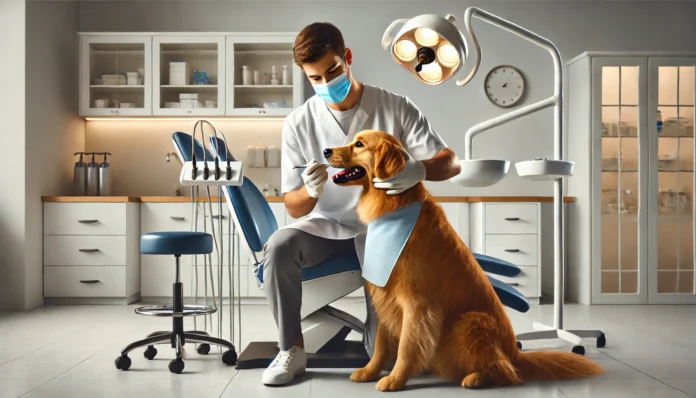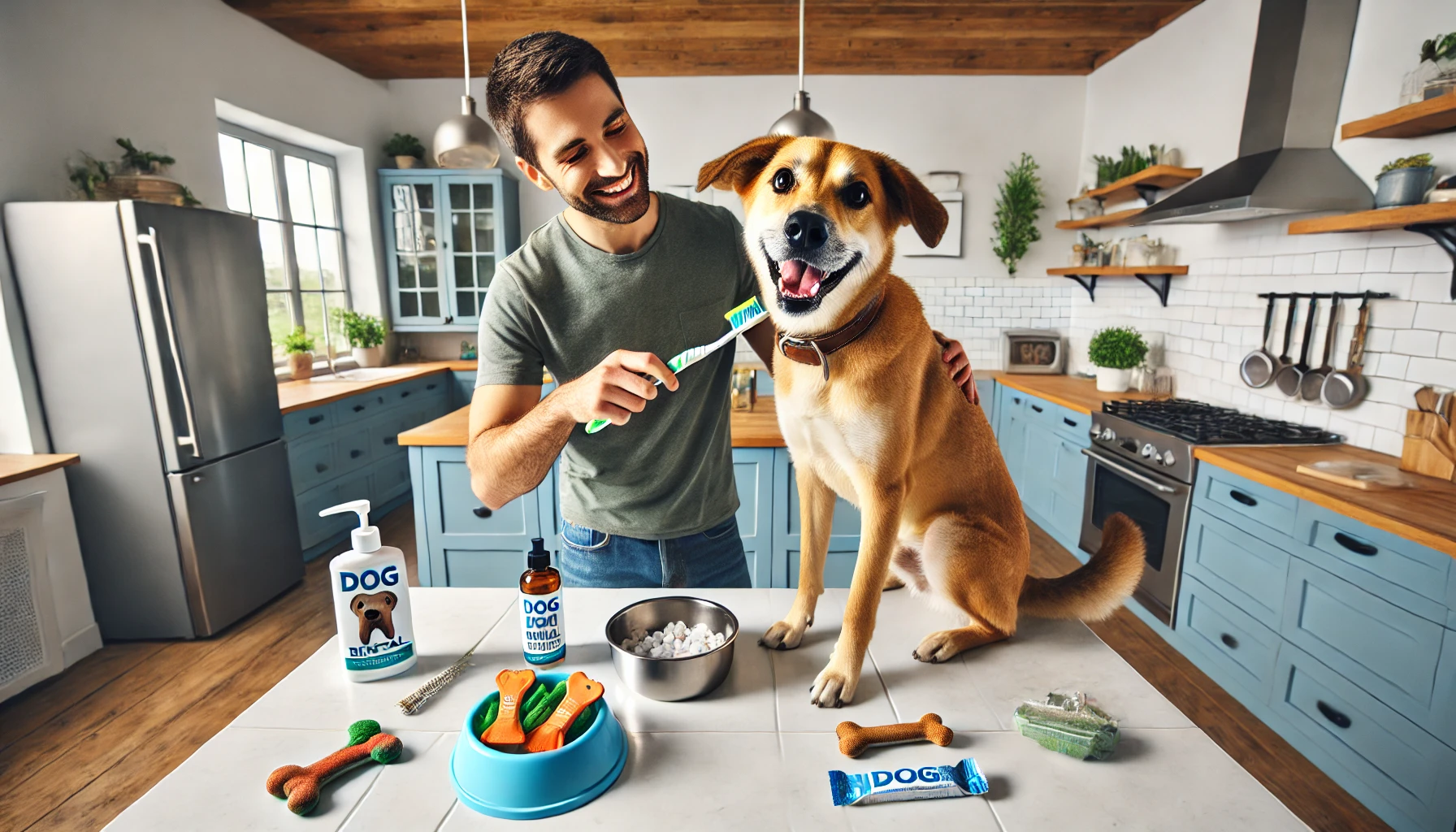Why Dental Cleaning Is Crucial for Your Dog’s Health
How Long Do Dog Dental Cleanings Take? For pet owners, understanding the importance of dental care and the procedure itself is vital. This blog dives into the process, costs, and how to maintain your dog’s oral health effectively.
Dogs, like humans, need proper dental care to stay healthy. Regular dental cleaning plays a big role in keeping them safe from problems. It’s not just about clean teeth; it’s about their overall well-being. Here’s why dental care is important and what happens if it’s ignored.
Learn more about the dental disease dog teeth cleaning before and after and how to manage them.
Importance of Regular Dental Care in Dogs
Regular dental care helps prevent major health issues in your dog. Plaque and tartar build up on their teeth just like ours. Over time, this leads to problems like gum disease, infections, and bad breath. Cleaning removes harmful bacteria that can affect not just the mouth but the entire body.
Protect your dog from health risks! Find out more about the Derry Dog Park Health Issue.
Veterinary cleanings are like deep cleanings for your dog. They go beyond what home brushing can do. When dogs get proper dental care, they are happier, eat better, and avoid painful conditions. Healthy teeth mean your dog stays active and enjoys their life to the fullest.
Learn more about the dog dental cleaning before and after and how to manage them.
Consequences of Neglecting Oral Hygiene
Ignoring dental care for dogs can lead to serious problems. Bad breath is the first sign, but it’s just the beginning. If left untreated, plaque hardens into tartar, causing inflammation and gum disease. This condition, called gingivitis, can make eating painful for your dog.
As things worsen, infections may spread from the gums into the bloodstream. This can damage the heart, liver, and kidneys. In some cases, neglecting dental care results in tooth loss. Imagine how hard it is for a dog to chew without teeth. Regular care can prevent these heartbreaking scenarios.
Want more tips on keeping your pup healthy? Check out our complete guide to dog dental cleaning for expert advice!
Brief Comparison: Human Dental Care vs. Dog Dental Care
Dog dental care and human dental care share some similarities, but they also differ. Like us, dogs need regular brushing, professional cleanings, and check-ups to maintain healthy teeth. However, dogs can’t tell us when something hurts, so it’s up to owners to notice the signs.
One key difference is that dogs often need anesthesia for professional cleanings. This ensures the vet can clean under the gum line thoroughly and safely. Unlike humans, dogs won’t sit still for a cleaning session. Regular home care paired with vet visits keeps their teeth strong, just like regular brushing does for us.
Want to give your Chinook the best life? Start by understanding their health needs: Read More
Common Signs Your Dog Needs a Dental Cleaning
Dental problems in dogs don’t always show up right away. You might not notice issues until they become serious. Paying attention to warning signs helps you act before it’s too late. Here are some of the most common signs your dog needs a dental cleaning.
Persistent Bad Breath
If your dog’s breath smells unpleasant, it’s a major sign of dental trouble. Bad breath comes from bacteria growing in the mouth. While occasional bad breath is normal, persistent odor suggests plaque buildup or infection. If you notice this, it’s time for a check-up.
Difficulty Eating or Chewing
Does your dog avoid food or chew slower than usual? Pain from inflamed gums or broken teeth could be the cause. Dogs often hide discomfort, but changes in eating habits are a red flag. Dental cleaning can relieve the pain and restore their appetite.
Discolored Teeth or Tartar Buildup
Healthy dog teeth are white and clean. If you see yellow or brown spots on your dog’s teeth, it’s tartar. This buildup leads to further problems like gum disease if ignored. Regular cleanings remove tartar and keep teeth shiny.
Swollen, Bleeding Gums
Red, swollen, or bleeding gums are signs of gingivitis. Healthy gums should be pink and firm. If you notice swelling, it means bacteria are causing damage. Bleeding gums often occur during eating or chewing on toys. These symptoms should not be ignored.
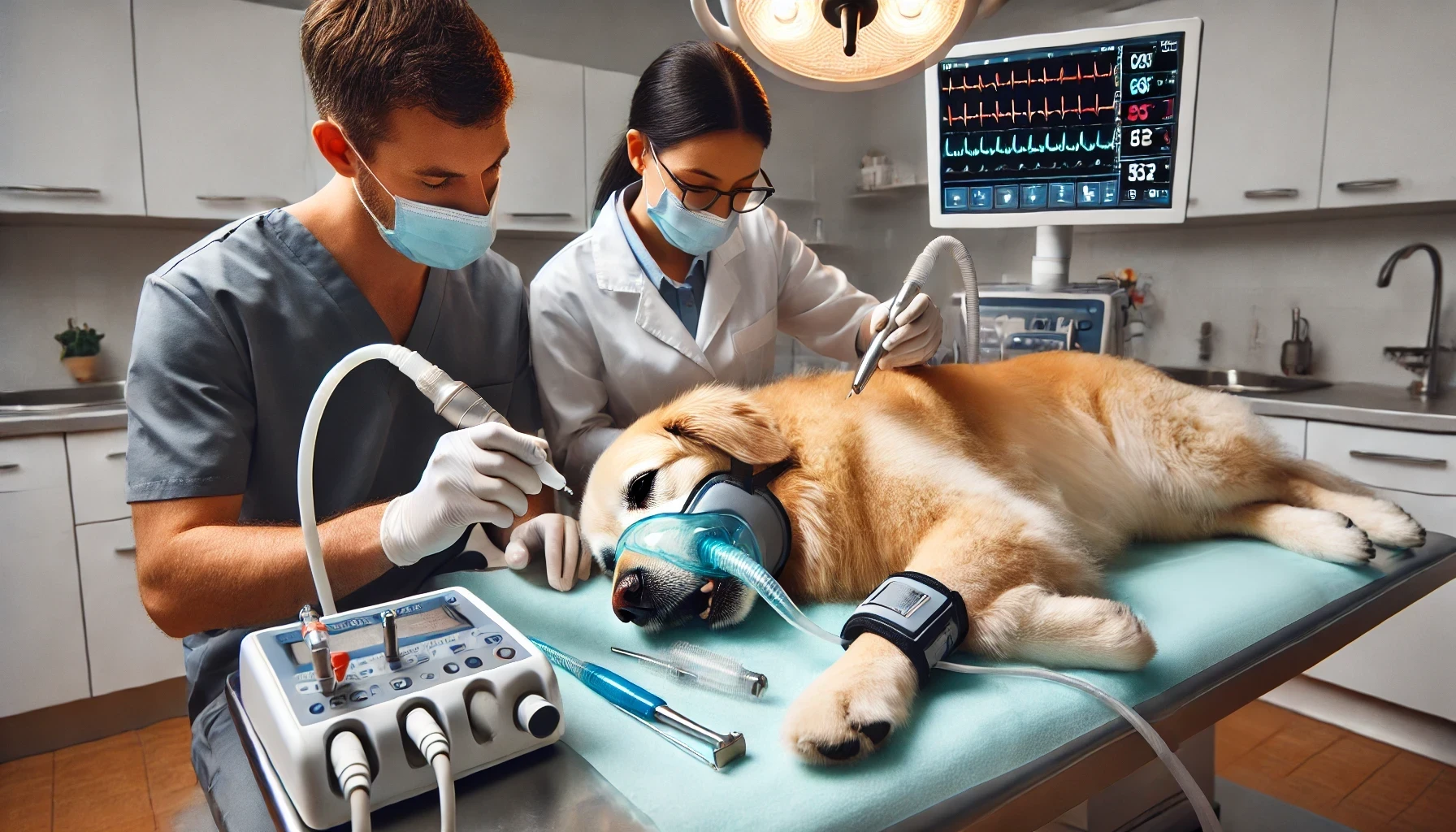
Understanding the Dog Dental Cleaning Procedure
Dental cleaning for dogs is a comprehensive process designed to keep their teeth and gums healthy. It’s more than just a routine check-up; it involves detailed steps that ensure thorough cleaning and prevention of future issues. Here’s a breakdown of what happens during a professional dental cleaning.
Learn more about the dental health in dogs guidelines and how to manage them.
Step-by-Step Breakdown of the Procedure
Every dog dental cleaning begins with careful preparation and ends with recovery. These steps ensure your dog gets the best care possible.
- Pre-Cleaning Examination and Blood Work
Before starting, the vet performs a physical exam to check your dog’s overall health. Blood tests ensure the dog is fit for anesthesia. This step is crucial for detecting underlying health issues that might pose risks during the procedure. - Administering Anesthesia
Dogs need anesthesia for their safety and comfort during cleaning. It keeps them calm and still, allowing the vet to clean thoroughly without causing stress or pain. The dosage is carefully calculated based on the dog’s weight and health condition. - Cleaning and Scaling Teeth (Above and Below Gum Line)
Once under anesthesia, the vet uses specialized tools to remove plaque and tartar. Cleaning beneath the gum line is essential, as bacteria hiding there can cause infections and gum disease. This part ensures no area is left untreated. - Polishing and Fluoride Treatment
After cleaning, the teeth are polished to smooth the surface. This helps prevent future plaque buildup. A fluoride treatment is often applied to strengthen the enamel and protect against cavities. - Post-Cleaning Examination and Recovery
Once the cleaning is complete, the vet examines the teeth and gums for any lingering issues. The dog is moved to recovery, where they’re monitored closely as the anesthesia wears off. Most dogs wake up within a few hours and are ready to go home.
How Long Does the Procedure Take?
The duration of a dog’s dental cleaning varies depending on several factors. Here’s what can affect the time:
- Severity of Dental Issues: Dogs with significant tartar buildup or gum disease may require more time to clean thoroughly.
- Dog’s Age and Health: Senior dogs or those with underlying health issues may need extra care and monitoring, extending the procedure time.
- Anesthesia Response: Some dogs take longer to respond to or recover from anesthesia, which can add time to the process.
Average Time: A standard dental cleaning usually takes 1-2 hours. However, additional procedures like extractions or x-rays can extend the duration. Each case is unique, so your vet will provide a time estimate based on your dog’s specific needs.
Anesthesia Safety for Dogs
Anesthesia is a critical part of the dental cleaning process. It ensures your dog’s comfort and allows the vet to perform the procedure effectively. Here’s what you need to know about anesthesia safety.
- Types of Anesthesia Used
Most vets use general anesthesia, which puts the dog into a deep sleep. This type is preferred for dental procedures because it ensures the dog feels no pain and remains still throughout. - Special Considerations for Senior or Health-Compromised Dogs
Older dogs or those with chronic conditions require extra attention. Vets perform thorough health checks and adjust the anesthesia dosage carefully to reduce risks. Monitoring is especially rigorous for these dogs. - Monitoring During the Procedure
While under anesthesia, your dog’s vital signs—heart rate, breathing, and oxygen levels—are constantly monitored by trained staff. Advanced equipment ensures any irregularities are addressed immediately, keeping the procedure as safe as possible.
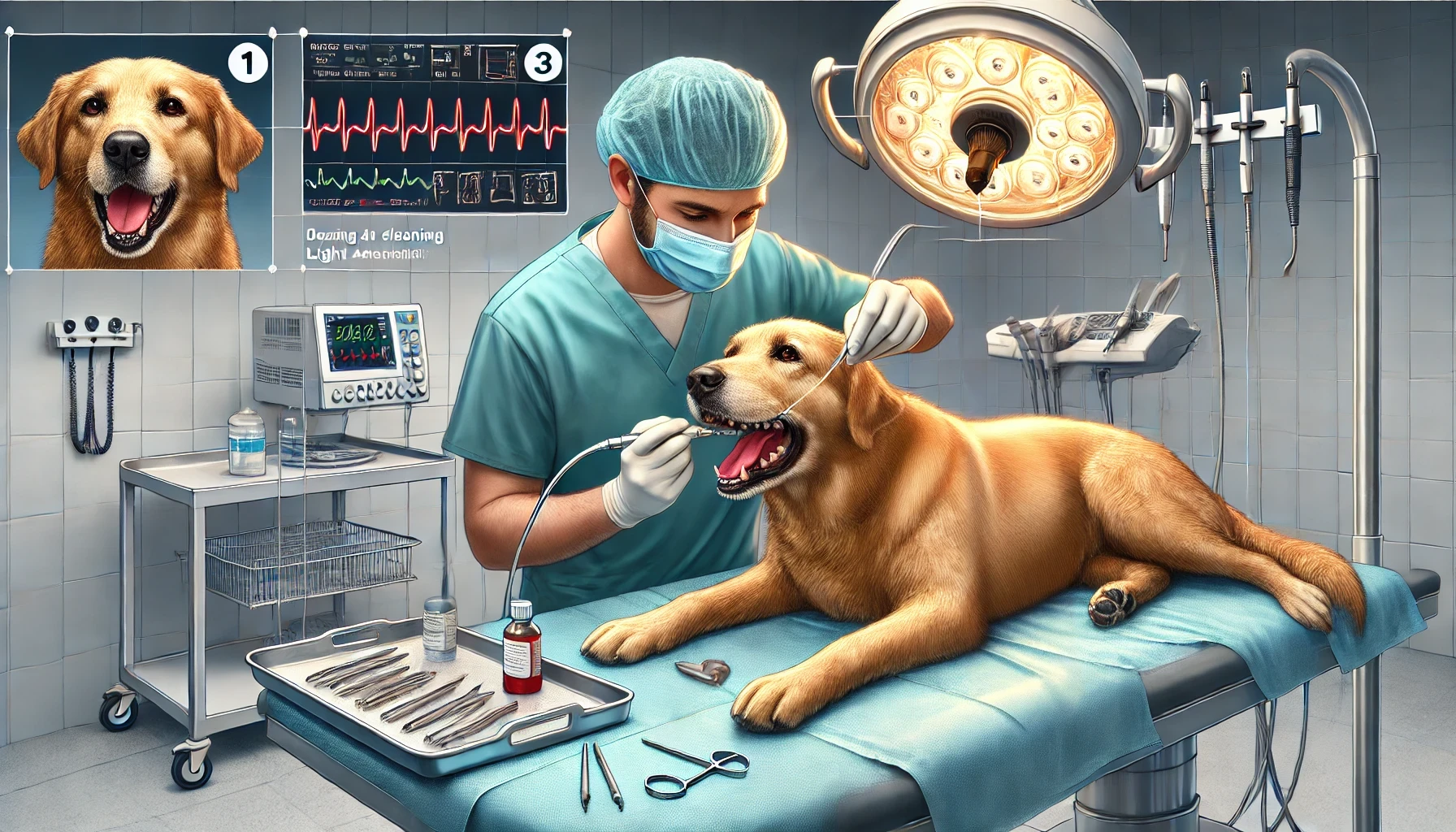
Post-Procedure Care: Helping Your Dog Recover
After your dog’s dental cleaning, proper post-procedure care is essential to ensure a smooth recovery. By following a few key steps, you can help your furry friend bounce back quickly while avoiding potential complications. Here’s everything you need to know about helping your dog recover.
You can learn more about Common Health Issues in our detailed guide here.
Immediate Aftercare Tips
The first 24 to 48 hours after a dental cleaning are crucial for recovery. Here are some simple yet effective ways to support your dog during this time:
- Keep Your Dog Calm
After anesthesia, your dog may feel drowsy or disoriented. Create a quiet, comfortable space where they can rest undisturbed. Avoid loud noises, bright lights, and unnecessary handling during the recovery period. - Monitor Anesthesia Recovery
Watch for signs of lingering effects from anesthesia, such as grogginess or unsteady movement. While mild symptoms are normal, contact your vet immediately if your dog seems overly lethargic or has difficulty breathing. - Provide Plenty of Fresh Water
Anesthesia can cause mild dehydration. Make sure your dog has access to clean, fresh water at all times. Encourage small sips rather than large gulps to prevent vomiting. - Limit Activity
Prevent your dog from running, jumping, or playing energetically for at least 24 hours. Overexertion can strain their mouth or slow down the healing process.
What to Feed Your Dog After Dental Cleaning
Your dog’s mouth may feel sensitive after a cleaning, so adjusting their diet temporarily is important. Proper food choices can promote comfort and healing.
- Soft or Wet Food Recommendations
Stick to soft or wet foods for the first few days post-procedure. Canned dog food, boiled chicken, or plain rice are excellent options. They are easy to chew and won’t irritate sensitive gums. - Avoiding Hard Treats or Toys
Steer clear of crunchy kibble, rawhide, or hard toys for at least a week. These items can hurt your dog’s teeth and gums, delaying recovery or causing discomfort. - Introduce Normal Foods Gradually
After a few days, slowly reintroduce their regular diet. Mix their soft food with kibble in small amounts to help them adjust.
Signs of Complications to Watch For
While most dogs recover well from dental cleaning, it’s vital to recognize potential signs of complications. Acting quickly can prevent minor issues from becoming serious.
- Excessive Drooling or Bleeding
Mild drooling or light bleeding is normal immediately after the procedure. However, if drooling becomes excessive or bleeding persists beyond a day, consult your vet. These could be signs of irritation or infection. - Loss of Appetite
Some dogs may eat less due to mild discomfort, but they should resume normal eating within 24-48 hours. If your dog refuses food for more than two days, it’s time to call the vet. - Behavioral Changes
Keep an eye on your dog’s behavior. Signs of pain, such as whining, pawing at their mouth, or avoiding interaction, could indicate lingering issues. Lethargy or aggression is also a cause for concern.
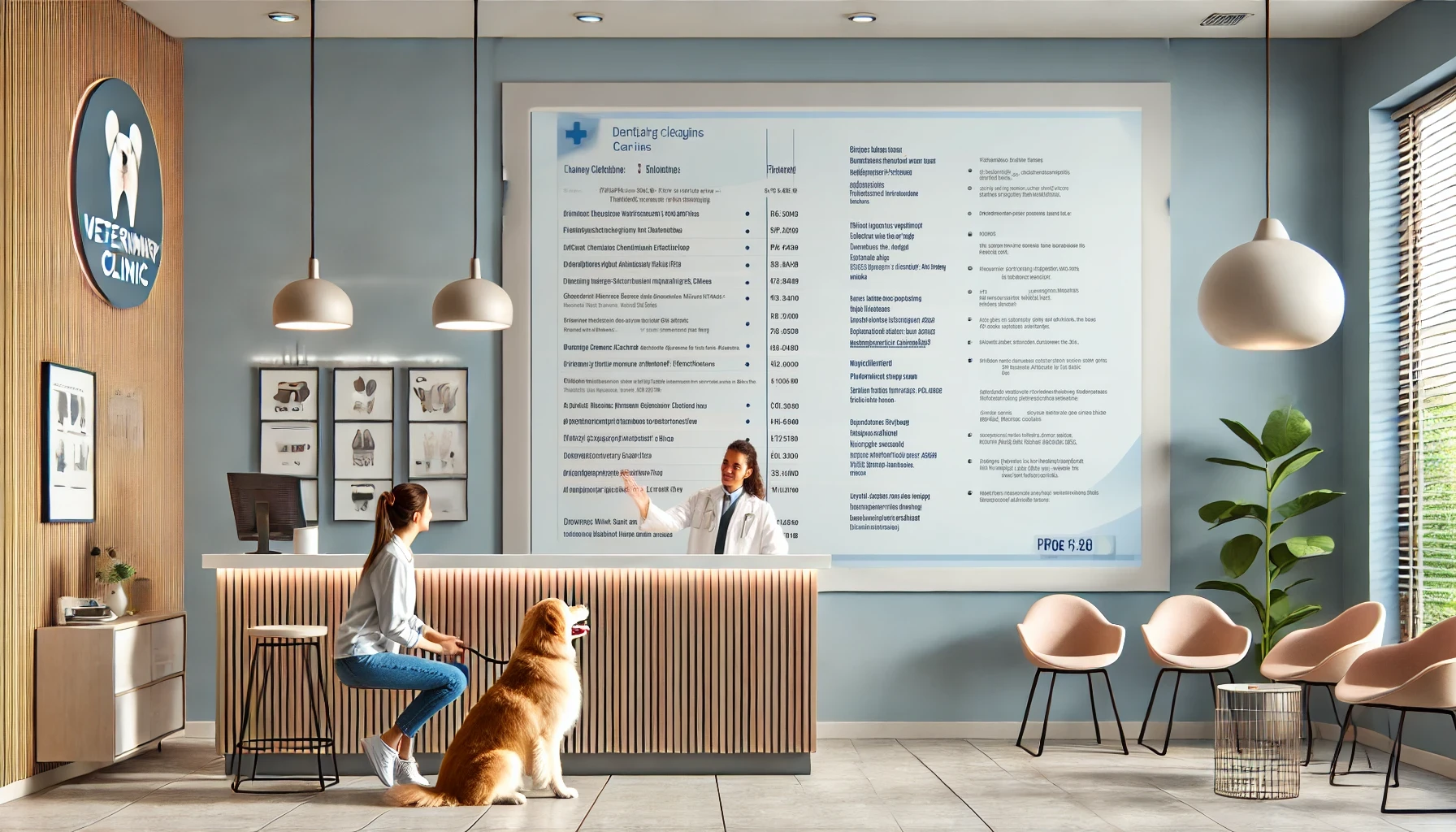
Costs of Dog Dental Cleaning
Understanding the costs of dog dental cleaning is essential for planning your pet’s care. Dental cleaning is an investment in your dog’s health, but several factors can influence the price. Let’s break down the costs and ways to save money while ensuring the best care for your furry friend.
Average Cost Range and Factors Influencing Pricing
Dog dental cleaning costs can vary widely based on different factors. On average, the price ranges from $300 to $700 for a standard cleaning. Additional procedures, such as tooth extractions, can increase costs significantly.
Factors That Influence Pricing:
- Geographic Location
Veterinary costs vary depending on your location. Urban areas and regions with a higher cost of living often charge more for dental procedures than rural areas. - Dog’s Size and Age
Larger dogs require more resources, such as anesthesia, making their dental cleanings more expensive. Senior dogs might need extra care, adding to the overall cost. - Severity of Dental Issues
A routine cleaning for mild plaque buildup costs less than addressing advanced tartar, gum disease, or multiple tooth extractions.
Cost Comparison of Dental Cleaning Based on Dog Size
The table below provides a general idea of what dental cleaning might cost depending on your dog’s size:
| Dog Size | Estimated Cost | Additional Costs |
| Small (e.g., Chihuahua) | $300 – $450 | Tooth extraction: $100/tooth |
| Medium (e.g., Beagle) | $400 – $600 | Advanced cleaning: $200 extra |
| Large (e.g., Labrador) | $500 – $700 | X-rays: $150 – $300 |
Note: These are approximate costs. Always consult your vet for an accurate estimate based on your dog’s needs.
Tips to Reduce Costs
While dental cleaning can be costly, there are ways to manage expenses without compromising on quality care. Here are some helpful tips:
- Invest in Pet Insurance
Many pet insurance plans cover dental cleanings or offer partial reimbursement. Look for policies that include routine care and dental procedures to save money long-term. - Schedule Regular Check-Ups
Regular dental check-ups help catch issues early, reducing the need for expensive procedures. Preventative care is always cheaper than treating advanced problems. - Maintain Oral Hygiene at Home
Brushing your dog’s teeth regularly can delay or prevent the need for professional cleanings. Use vet-recommended dental chews and toys to reduce plaque buildup. - Shop Around for Clinics
Prices can vary between veterinary clinics. Call multiple clinics in your area to compare costs and services. - Consider Veterinary Schools
Some veterinary schools offer discounted services, including dental cleanings, as part of their training programs. These are performed under the supervision of experienced professionals.
Preventing Future Dental Issues in Dogs
Preventing dental issues in dogs is easier and more cost-effective than treating them. A combination of proper home care, routine professional cleanings, and a healthy diet ensures your dog’s teeth and gums remain strong and healthy. Let’s explore these strategies to protect your furry friend’s dental health.
You can learn more about Top Dog Health And Wellness in our detailed guide here.
Home Dental Care Tips
Caring for your dog’s teeth at home is the first step in preventing dental problems. Regular maintenance keeps plaque and tartar under control, reducing the risk of gum disease and tooth loss.
- Brushing Techniques and Tools
Brushing your dog’s teeth may sound tricky, but it’s one of the most effective ways to maintain oral health. Use a vet-approved dog toothpaste (never human toothpaste) and a soft-bristled toothbrush designed for pets. Start slowly, letting your dog get used to the process. Focus on the gum line, as this is where plaque builds up. Aim to brush at least 2-3 times a week for the best results. - Recommended Dental Chews and Toys
Dental chews and toys are excellent for reducing plaque and keeping your dog’s teeth clean. Look for products with the Veterinary Oral Health Council (VOHC) seal of approval. Chew toys with textures or ridges can help scrub teeth naturally as your dog chews. Always supervise your dog to prevent choking hazards.
Regular Professional Cleanings
While home care is crucial, professional cleanings are an essential part of your dog’s dental health routine. They address issues that can’t be resolved with brushing or chews alone.
- Frequency Recommendations Based on Dog’s Age and Breed
Puppies and younger dogs typically require less frequent cleanings, while senior dogs and breeds prone to dental problems, such as small or flat-faced breeds, may need cleanings more often. On average, most dogs benefit from a professional cleaning once a year. Your vet may recommend more frequent cleanings if your dog has specific dental concerns. - Benefits of Routine Veterinary Visits
Regular dental check-ups allow your vet to monitor your dog’s oral health and catch issues early. Professional cleanings remove plaque and tartar below the gum line, which helps prevent gum disease and infections. They also allow the vet to spot and address potential issues like loose or damaged teeth before they escalate.
Diet and Supplements for Healthy Teeth
What your dog eats plays a significant role in their dental health. A balanced diet and targeted supplements can strengthen teeth and prevent common issues.
- Foods That Promote Dental Health
Incorporate foods designed to support oral health into your dog’s diet. Dry kibble is better than wet food for reducing plaque since it creates a natural scrubbing effect as your dog chews. Some dog foods are specifically formulated to reduce tartar buildup—ask your vet for recommendations. - Calcium and Vitamin Supplements
Supplements can fill nutritional gaps and support dental health. Calcium strengthens teeth and bones, while vitamins like C and D promote healthy gums and tooth enamel. Always consult your vet before introducing new supplements to ensure they’re safe and effective for your dog.
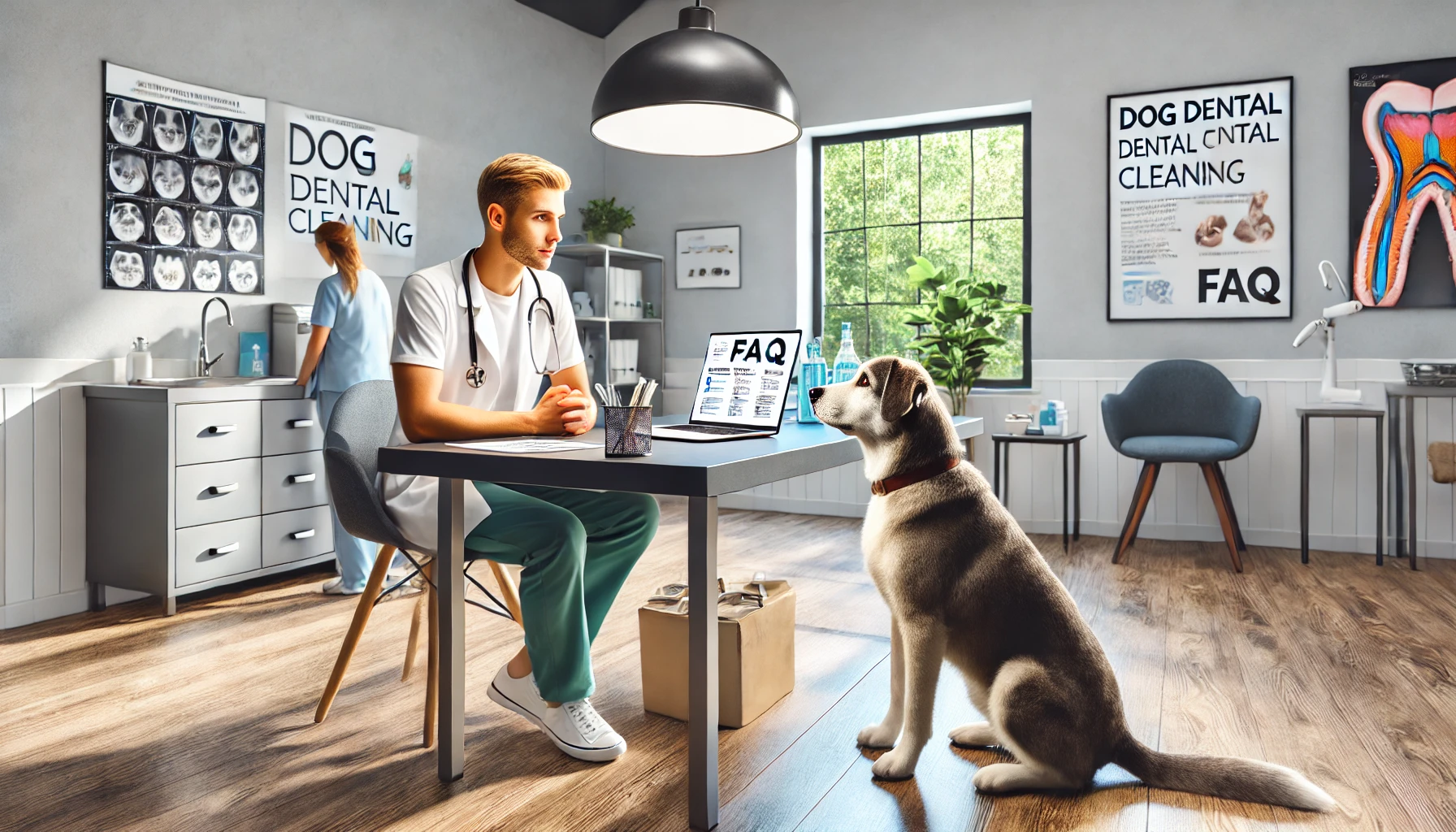
Frequently Asked Questions About Dog Dental Cleanings
Dog dental cleaning is a topic that raises many questions for pet owners. Knowing the answers can help you make informed decisions about your dog’s oral care. Here are the most common questions and detailed answers to guide you.
How often should I clean my dog’s teeth professionally?
Professional teeth cleaning is necessary for maintaining your dog’s oral health. On average, most dogs need professional cleaning once a year. However, the frequency depends on your dog’s age, breed, and overall health.
- For Puppies and Younger Dogs: Typically, younger dogs with healthy teeth may only need cleanings every 1-2 years, as long as you maintain good home care.
- For Senior Dogs and At-Risk Breeds: Older dogs and breeds prone to dental problems (like toy breeds or brachycephalic dogs) may require cleanings more frequently, often every 6-12 months.
Your vet will assess your dog’s dental health and recommend a cleaning schedule that fits their specific needs.
Is anesthesia always necessary for dental cleaning?
Yes, anesthesia is typically required for professional dental cleaning to ensure thorough and safe treatment. Here’s why:
- Benefits of Anesthesia: It keeps your dog still, allowing the vet to clean below the gum line and examine the mouth fully. Without anesthesia, your dog might move unexpectedly, making the process unsafe and less effective.
- Alternatives to Anesthesia: Non-anesthetic cleanings are available but are limited to surface cleaning. They do not address issues below the gum line, which are critical for preventing gum disease and infections.
Always discuss anesthesia options with your vet, especially for senior dogs or those with underlying health issues.
What’s the difference between anesthetic and non-anesthetic cleanings?
Understanding the difference can help you choose the right option for your dog.
- Anesthetic Cleanings:
- What It Covers: Cleans above and below the gum line, removes tartar, and treats periodontal disease.
- Advantages: More thorough and allows for x-rays or extractions if needed.
- Drawbacks: Requires anesthesia, which carries some risks, especially for older or health-compromised dogs.
- Non-Anesthetic Cleanings:
- What It Covers: Cleans the visible surface of the teeth.
- Advantages: No anesthesia required, making it safer for some dogs.
- Drawbacks: Does not address issues below the gum line, so it’s not a substitute for anesthetic cleanings.
While non-anesthetic cleanings are useful for maintenance, they should not replace anesthetic cleanings for dogs with significant dental issues.
How long does it take for a dog to recover fully?
Most dogs recover quickly after a dental cleaning, but the exact time depends on the procedure and your dog’s overall health.
- Mild Cleaning: Recovery from anesthesia and minor cleaning usually takes 24-48 hours. During this time, your dog might feel drowsy and need extra rest.
- Complex Cleaning or Extractions: If your dog needed tooth extractions or treatment for gum disease, recovery might take 3-7 days. You’ll need to monitor them closely and follow your vet’s aftercare instructions.
If your dog shows signs of prolonged discomfort, loss of appetite, or behavioral changes, contact your vet immediately.
What are the risks of not cleaning my dog’s teeth?
Neglecting dental care can lead to serious health problems that go beyond your dog’s mouth.
- Gum Disease and Tooth Loss: Plaque buildup leads to gum inflammation, infections, and eventually tooth loss. This can cause pain and make eating difficult for your dog.
- Systemic Health Issues: Bacteria from gum disease can enter the bloodstream, affecting organs like the heart, liver, and kidneys. This condition, known as systemic infection, can be life-threatening.
- Chronic Pain: Dental problems can cause ongoing pain, reducing your dog’s quality of life.
Regular dental cleanings prevent these risks, ensuring your dog stays healthy and happy.
Real-Life Case Studies: Dental Cleaning Success Stories
Real-life experiences often provide the most reassurance and motivation for taking action. Here are two success stories from dog owners whose pets underwent dental cleanings. These examples highlight the benefits of proper dental care and the difference it can make in a dog’s health and happiness.
Brief Testimonials from Dog Owners About Their Experience
- Lila’s Testimonial:
“After Bella’s dental cleaning, her energy completely changed. She was no longer hesitant to eat, and her breath is so much better. I was nervous about the anesthesia, but the vet explained everything, and she recovered quickly. I’ll never delay her cleanings again!” - John’s Testimonial:
“Rusty had been avoiding his favorite chew toys, and I didn’t realize how bad his teeth were until the vet showed me. The cleaning made a huge difference. He’s like a puppy again, playing and eating without any issues.”
Example 1: Recovery of a Senior Dog After a Complex Cleaning
Bella, a 12-year-old Labrador Retriever, had been showing signs of dental discomfort. She avoided hard food, drooled excessively, and had noticeable tartar on her teeth. Her owner, Emma, worried about the risks of anesthesia due to Bella’s age, but her vet assured her that thorough pre-cleaning exams would minimize risks.
- Procedure Details:
Bella underwent a comprehensive dental cleaning, which included x-rays and the removal of three damaged teeth. The vet also treated her gums to prevent further infection. - Recovery:
After the cleaning, Bella experienced slight grogginess from the anesthesia but recovered within 48 hours. Emma followed the vet’s advice by feeding her soft foods and avoiding hard treats for a week. - Outcome:
Within days, Bella was eating better and seemed more energetic. Her bad breath was gone, and her playful personality returned. Emma was thrilled with the results and now schedules regular cleanings to maintain Bella’s dental health.
Example 2: Improved Health of a Dog with Severe Tartar Buildup
Max, a 5-year-old Shih Tzu, suffered from severe tartar buildup and gum inflammation. His owner, David, noticed Max’s reluctance to eat and occasional whining during meals. A vet check-up confirmed the need for immediate dental cleaning.
- Procedure Details:
Max’s cleaning involved scaling and polishing his teeth, along with a fluoride treatment to protect his enamel. The vet also provided David with tips for maintaining Max’s oral health at home. - Recovery:
Max showed remarkable improvement just a day after the procedure. The vet advised David to incorporate daily brushing and dental chews into Max’s routine to prevent future tartar buildup. - Outcome:
Max regained his appetite and enthusiasm for playtime. David noted that Max seemed happier and more active. He now ensures Max’s dental care is part of his overall health routine.
Final Thoughts: Ensuring Long-Term Oral Health for Your Dog
Caring for your dog’s teeth is not just about fresh breath and clean teeth; it’s about their overall health and happiness. Dental issues can lead to pain, infections, and even life-threatening conditions if left untreated. By prioritizing your dog’s oral health, you’re giving them the best chance at a long, healthy, and joyful life.
Learn more about the common health issues in Boxer dogs and how to manage them.
Recap of the Importance of Dental Cleanings
Professional dental cleanings are essential for removing plaque and tartar that home care alone can’t address. These cleanings prevent gum disease, tooth loss, and infections that could harm your dog’s organs. Beyond physical health, proper dental care improves your dog’s quality of life, allowing them to eat, play, and thrive without discomfort.
By addressing dental issues early and maintaining a regular cleaning schedule, you’re investing in your dog’s future. Remember, healthy teeth contribute to a healthy body!
Encouragement to Maintain Regular Dental Care at Home
While professional cleanings are vital, consistent home care is the foundation of good dental health. Brushing your dog’s teeth, providing dental chews, and feeding a balanced diet can help reduce plaque buildup and maintain healthy gums. Small, regular efforts at home can make a big difference in extending the time between professional cleanings and keeping dental problems at bay.
Building a routine might feel challenging at first, but it becomes easier over time. Your dog will thank you with better health, a wagging tail, and lots of happy moments.
Schedule a Dental Check-Up for Your Dog Today!
There’s no better time to start caring for your dog’s teeth than now. If your dog hasn’t had a dental check-up recently, contact your veterinarian to schedule one today. A quick visit could uncover hidden issues and set your dog on the path to better health.
Your furry friend relies on you for their well-being, and dental care is a crucial part of that responsibility. Take the first step towards ensuring their long-term health and happiness by booking that check-up. They’ll thank you with endless love and loyalty!
Popular Article
Dental Health in Dogs Guidelines
Dental disease dog teeth cleaning before and after
What to Feed Dog After Dental Cleaning
Can dog annual vaccinations be done during dental cleaning
How often do dogs need dental cleaning
Can dogs get dental implants
clindamycin dosage for dog’s dental
cobber dog health issues


